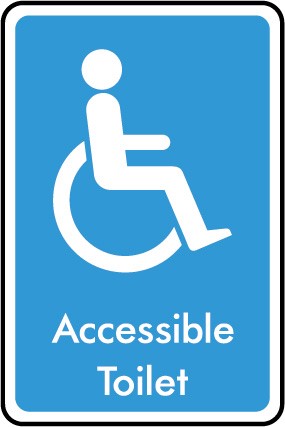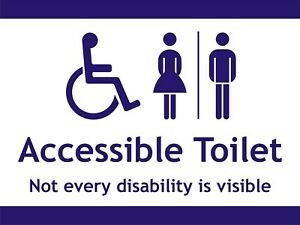by Dave Campbell
Chair | Metropolitan Police Service Disability Staff Association
Accessible toilets: why do we have them and why do we need them?
The provision of accessible toilet facilities is fundamental in the modern workforce as well as being a crucial part of being an inclusive organisation. It is also a legal requirement and is covered under both the Equality Act and Building Regulations.
The Equality Act 2010, states that all organisations have a duty to provide accessible goods and services to their disabled workforce. The provision of accessible toilet facilities is a fundamental and crucial part of inclusive service delivery, therefore their design and management warrant careful attention.
According to the Government’ s data capture body (Office for National Statistics – ONS) approximately 18-23% of the adult UK workforce will have a disability. This equates to about 8,000 people in our organisation that are likely to have some form of disability, in a workforce of 46,000.

Accessible toilets are useful for a broad range of people who are either permanently or temporarily disabled – they provide an important provision for disabled persons to use the facility independently and as safely as possible. The guidance in Building Regulations was a result based on many years of campaigning by disability rights groups and research into the broad church of issues that disabled persons face in the workplace and public areas; and so the design, positioning and exclusivity of use of accessible toilets should be followed exactly as intended, because all of the requirements contained within are essentially important to someone.
What may appear to be a small and insignificant detail to some may pose a real element of difficulty or even danger to a disabled person. On many accessible toilets in the workplace as well as in public areas, we may see signs that look similar to the one presented above, which make us think that its use is confined to wheelchair users only.

Notably 70% of all disability is hidden, which means that it is difficult to assess if a person using the facility really needs to, so there has to be an element of widespread trust, consideration and common sense. If you don’t really need to use the facility of an accessible toilet, then simply put: don’t!
Most significantly, the working age of our organisation is changing and likely to get older in the future due to changes in our pensions, compulsory retirement and retirement age. Many people are working beyond anticipated retirement age. The UK has an ageing population with over 40% of the population aged over 45 years – the age at which the incidence of disability begins to increase significantly. As we live longer and in comparison to previous generations, age brings an increasing chance of disability or impairment.
So what is the difference between an accessible toilet and a regular toilet? Both may be used by differently abled people, but the fundamental differences are in the design and layout, the available space, cubicle layout, the flooring, the hand-grip equipment, the lighting, the alarm system, height of amenities such as wash basin, toilet paper, and so on. The toilet, above all else, removes the disabling barriers and limitations that exist for people with disabilities in regular toilets.
The accessible facility’s wider access doors and bigger room/cubicle area provides adequate space to manoeuvre safely with or without walking aids, wheelchairs or assistance dogs. Toilets seats are raised higher to make it easier to stand up and sit down. By raising the seat of an accessible toilet, transfers to/from a wheelchair are also safer as the seat height is more equal between the two. Wash basins are equally set at a height to aid ease of use. Taps are different so they are operable by people with limited strength or manual dexterity – they should be operable either by automatic sensor or lever action (capable of being operated using a closed fist). The surface finish of sanitary fittings and grab bars generally contrast visually with background wall and floor finishes. Specific heights are specified for placements of full and half-length mirrors, which are useful to persons changing stomas. Such attention to detail also applies to placement on soap dispensers, paper and toilet paper dispenser, and hand dryers.
An accessible toilet is designed to meet the majority of needs of independent wheelchair users and people with mobility impairments, as well as the additional requirements of people with bowel and bladder conditions. It also helps people with impaired dexterity, grip or balance, and other conditions where physical support from grab rails and the presence of an emergency alarm is helpful. It may also be a place where someone can have privacy to change a colostomy bag or stoma, and to self-medicate such as administering injections, e.g. insulin. In terms of health and safety, should someone fall or slip there will be an alarm cord sited within the unit to alert the need for assistance.
In most buildings you will find more regular toilets available than accessible toilets: for example in many buildings there may be female/male or gender neutral toilets on all or several floors, as opposed to generally one accessible toilet in a number of our buildings which are usually situated on the ground floor and on a main exit/entry route. In our larger buildings there are of course a higher number of accessible facilities. Non-disabled colleagues have to a degree a choice of where to go; the choice for disabled persons are more limited.
Where accessible toilets are generally used because of ease of use rather than necessity, facilities can often became unusable or placed out of action due to lack of care in hygiene, lack of consideration (people not leaving the facility in a clean state), carelessness or misuse (blocked toilets). This could mean that no other facility is available for use, or overused so often by the general workforce that a person who needs to use them are unable to due to over-occupancy. This can also mean that these toilets are less safe for someone with mobility issues: they may be unable to change due to fear of slipping, have nowhere to place items to change, or be unable to administer medication or change a stoma dressing.
Lack of availability can be critical for colleagues that need to use facilities because of mobility and dexterity issues, irritable bowel disease, syndromes such as ulcerative colitis and Crohn’s disease, coeliac disease, fibromyalgia, and many other conditions requiring them to be located near to an accessible toilet.
Believe it or not, I get a number of complaints from our disabled colleagues across the MPS around the misuse of accessible toilets. Some have recounted experiences where due to facilities being out of service or left in an unusable state, staff have soiled themselves as they cannot access them. Often these services are out of use because they require the service of a plumbing specialist, or specialist cleaning due to the mess left. Many people are unable to manoeuvre in a regular toilet and may struggle to get to an accessible facility elsewhere in the building in time. This is not just confined to policing – many say this is a regular occurrence in shops, malls and other public areas where there is an accessible facility.
Furthermore, people often believe it is OK not to report a fault, or to leave an unhealthy mess left that poses a risk. This can impact on whether someone can come to work and stay at work – people have often expressed how degrading this can be. Where locks and a RADAR key locking mechanism are fitted, these have been damaged to gain access, which makes facilities unusable as they become insecure and less private, allowing someone to enter whilst they are in use. Facilities that suffer from these issues are often left out of action for days if the problem is more extensive.
These things do happen! Is it really acceptable in 2022? How would you feel if your loved one retuned from work distressed because of the lack of consideration from their colleagues?
There are no laws that state that non-disabled persons can’t use accessible toilets, and we’ve all been caught short at some point in our lives with the nearest useable toilet being the only option. Because much of disability can be hidden, it is not appropriate to challenge everyone who comes out of the cubicle as to whether they have as a legitimate reason to use the facility. It is important that people understand why accessible toilets exist and act with consideration, maintaining a disabled person’s right to common decency and dignity. ∎
This blog was originally published on the MPS intranet – it is reproduced here with kind permission of the author
